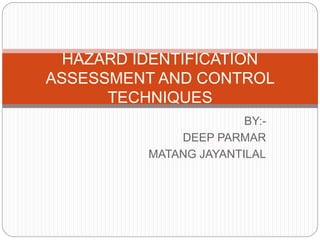
Hazard identification assessment and control techniques
- 1. BY:- DEEP PARMAR MATANG JAYANTILAL HAZARD IDENTIFICATION ASSESSMENT AND CONTROL TECHNIQUES
- 2. Introduction Safety in any operation works best if the person or people in charge take a leading role in managing safety and health. Many business enterprises have proven that good safety management leads to increased productivity, and the same works for farms. By having a good safety management program, you can avoid not only farm injuries, but also other incidents that are costly, time consuming, stressful and inconvenient. This makes good economic sense.
- 3. HAZARD Any thing which has potential to cause harm to the people and property is called hazard
- 4. Hazards may be identified in: • Environments (light, noise, rain, heat, sun) • Substances (pesticides, fuels, dusts) • Workplace layout (parlor designs, cattle passes). Work organization (unnecessary manual handling) Equipment (ladders, squeeze chutes, crowd gates) Farm animals (that bite, kick, butt, crush, toss, infect) Heights (roofs, vertical and horizontal silos, manure pits) Electricity (switches, cables, leads, power tools,
- 5. Hazards may be identified by: Observation - use your senses of sight, hearing, smell and touch - combined with knowledge and experience. Material Safety Data Sheets (MSDSs) - obtain them from manufacturers and suppliers. Read them carefully to identify possible harm from hazardous substances and precautions that need to be taken. Hazard and risk surveys - conduct hazard spotting surveys of main work areas. Talk to others about their safety concerns.
- 6. Record analysis - keep records of identified hazards, near misses, injuries and workers' compensation claims to help identify possible trends. Discussion groups - are useful for identifying hazards and recommending solutions. Safety audits - consider creating a safety committee to investigate safety and help prepare a management plan. Information - keep informed of hazards in the industry through the latest available information. Consumer information - carefully read and follow consumer guidelines on equipment and substances. Regulations and best practices
- 7. How to assess the risks in your workplace Identify the hazards Decide who might be harmed and how Evaluate the risks and decide on precautions Record your significant findings Review your assessment and update if necessary
- 8. Identify the hazards One of the most important aspects of your risk assessment is accurately identifying the potential hazards in your workplace. A good starting point is to walk around your workplace and think about any hazards. In other words, what is it about the activities, processes or substances used that could injure
- 9. Decide who might be harmed and how Think how employees (or others who may be present such as contractors or visitors) might be harmed. Ask your employees what they think the hazards are, as they may notice things that are not obvious to you and may have some good ideas on how to control the risks.
- 10. Evaluate the risks and decide on precautions Having identified the hazards, you then have to decide how likely it is that harm will occur; ie the level of risk and what to do about it. Risk is a part of everyday life and you are not expected to eliminate all risks. What you must do is make sure you know about the main risks and the things you need to do to manage them responsibly.
- 11. Record your significant findings Make a record of your significant findings - the hazards, how people might be harmed by them and what you have in place to control the risks. Any record produced should be simple and focused on controls
- 12. Review your assessment and update if necessary Few workplaces stay the same. Sooner or later, you will bring in new equipment, substances and procedures that could lead to new hazards. So it makes sense to review what you are doing on an ongoing basis, look at your risk assessment again and ask yourself: Have there been any significant changes? Are there improvements you still need to make? Have your workers spotted a problem? Have you learnt anything from accidents or near misses? Make sure your risk assessment stays up to date.
- 13. CONTROL TECHINQUE The hierarchy of control is used to remove or reduce hazards and risks and should be used during a risk assessment. The idea is that you start by choosing methods from the top of the list and work your way down if required Eliminate Reduce Isolate Control Personal Protective Equipment Discipline
- 15. Elimination Elimination Physically removing the hazard—is the most effective hazard control. For example, if employees must work high above the ground, the hazard can be eliminated by moving the piece they are working on to ground level to eliminate the need to work at heights.
- 16. Sublimation Sublimation Substitution, the second most effective hazard control, involves replacing something that produces a hazard (similar to elimination) with something that does not produce a hazard
- 17. Engineering controls Engineering controls The third most effective means of controlling hazards is engineered controls. These do not eliminate hazards, but rather isolate people from hazards. For example, a crew might build a work platform rather than purchase, replace, and maintain fall
- 18. Administrative controls Administrative controls Administrative controls are changes to the way people work. Examples of administrative controls include procedure changes, employee training, and installation of signs and warning labels (such as those in the Workplace Hazardous Materials Information System).Administrative controls do not remove hazards, but limit or prevent people's exposure to the hazards, such as completing road
- 19. Personal protective equipment Personal protective equipment (PPE) includes gloves, Nome/Uniform, res pirators, hard hats, safety glasses, high- visibility clothing, and safety footwear. PPE is the least effective means of controlling hazards because of the high potential for damage to render